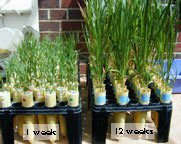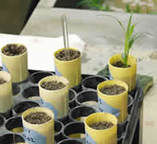Single Species Cultures
Establishment of Monospecific Cultures
Cultures of a single species usually must be started from carefully selected spores. These spores can originate from a field soil if they are healthy and infective, but probability of success varies greatly with soil type, amount of organic matter, and sometimes environmental conditions or seasons. Success appears to be greatest with sandy low organic matter soils. More consistent results are obtained using spores collected from pot cultures for obvious reasons: (i) many spores are newly formed and therefore usually healthy and more similar in age and (ii) morphological distinctions between species are easier to detect (minimizing contamination).
I. Spore Collection
Spores are extracted (method) from the source material (field or culture) 2-3 days before inoculation onto plant seedlings using sucrose density-gradient centrifugation. After repeated washing, the spores of each target species are collected manually with a pasteur pipette and stored in a watchglass (sealed in petri dish) at 4 degrees C. Spores are examined daily until the day of inoculation, and any with changed morphology (loss of contents, collapse, color change) or suggestion of parasitism are removed.
Before inoculation, water is added to the spore prep, the watch glass agitated, and any particles, hyphal fragments, or atypical spores are removed.
Note: a single hyphal fragment of any Glomus, Acaulospora, or Entrophospora species present in the initial extract can be highly infective and cause contamination (which won’t appear until the culprit fungus sporulates, and that often takes 2-3 pot culture cycles to occur).
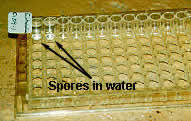 Cone-tainers (presterilized in 10% bleach) are first filled to the top
Cone-tainers (presterilized in 10% bleach) are first filled to the top 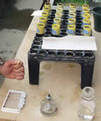 with sterile sand:soil mix, labels applied, and 6-7 cm deep holes made in centers with a sterile glass rod. They are arranged in the same pattern as spores are distributed in microtiter wells to avoid any confusion at the time of inoculation.
with sterile sand:soil mix, labels applied, and 6-7 cm deep holes made in centers with a sterile glass rod. They are arranged in the same pattern as spores are distributed in microtiter wells to avoid any confusion at the time of inoculation.
An alcohol lamp and a beaker of 95% ethanol is set up for flaming the glass rod after each transplant operation.
II. Seedling Preparation
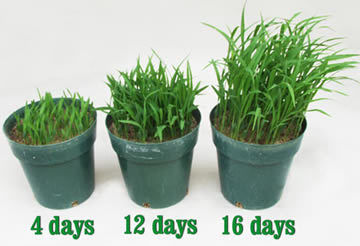 Approximately 12 days before a monospecific culture is planned on being set up, 40-50 sorghum seeds are evenly spaced in a 15-cm diameter pot using our standard sand-soil mix. This seeding rate provides enough seedlings for a given “run”, and they are far enough apart to separate without much damage to root systems. Sorghum is used in place of sudangrass because it has a hardier root system that buffers the seedling against transplant shock.
Approximately 12 days before a monospecific culture is planned on being set up, 40-50 sorghum seeds are evenly spaced in a 15-cm diameter pot using our standard sand-soil mix. This seeding rate provides enough seedlings for a given “run”, and they are far enough apart to separate without much damage to root systems. Sorghum is used in place of sudangrass because it has a hardier root system that buffers the seedling against transplant shock.

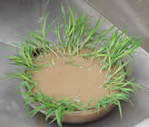
By 12 days, pot contents can be removed intact. This mass is placed in a large glass bowl filled with water so that it is completely immersed. Roots are gently teased from the growth medium and from each other and then left undisturbed for at least 30 minutes.
III. Inoculation
 Three seedlings are gently collected, placed together, and a gentle stream of water passed over roots so they “stick” together. Spores (in 200 µl water) are pipetted along the length of the intertwined roots, so they theoretically are contact with the maximum range of root physiological states. Spores adhere naturally while excess water drips from root tips.
Three seedlings are gently collected, placed together, and a gentle stream of water passed over roots so they “stick” together. Spores (in 200 µl water) are pipetted along the length of the intertwined roots, so they theoretically are contact with the maximum range of root physiological states. Spores adhere naturally while excess water drips from root tips.
The number of spores placed along roots varies with fungal species. Those that germinate readily and with high frequency (e.g. most Gigaspora, some Scutellospora and Glomus species) number 50-75. For all others, numbers range from 100-120 spores. Acaulospora species are the most unpredictable and so at least 100 spores are applied.
 Seedlings are immediately transplanted into the center hole of a cone-tainer. The glass rod is used to refill hole and compact soil around seedlings until they stand upright. Care is taken to distribute roots along length of the hole.
Seedlings are immediately transplanted into the center hole of a cone-tainer. The glass rod is used to refill hole and compact soil around seedlings until they stand upright. Care is taken to distribute roots along length of the hole.
The same procedure is used to inoculate single spores, but we do this only for specific experimental purpose and NEVER for accession material.
Cone-tainers are topped off with sterile growth medium (so there is at least a 2-cm lip for watering). All conetainers are watered gently and placed in a room with indirect lighting for 24 hr and then moved to greenhouse or growth room. Conetainers ARE NOT fertilized for at least 14 days after transplantation to optimize initial mycorrhizal development. The exception is when the potting medium consists of sand or some other soilless medium.
